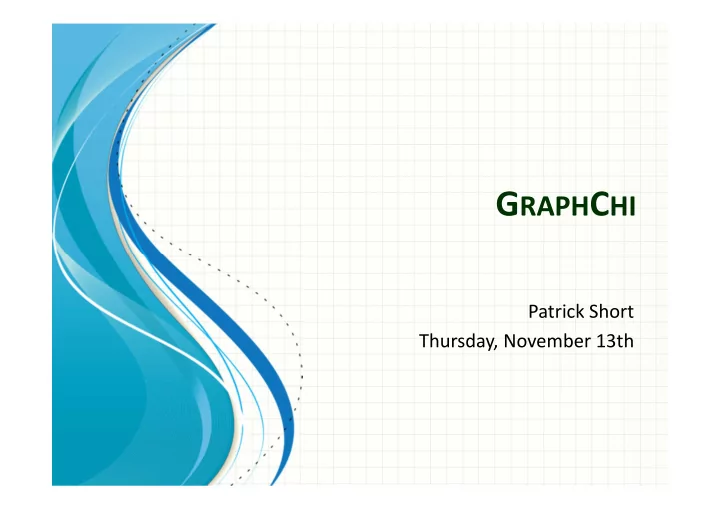

G RAPH C HI Patrick Short Thursday, November 13th
GraphChi(huahua) Overview • The Punchline • Quick Overview • Novel Method – Parallel sliding windows • Use Cases and Caveats
GraphChi is in the ballpark with massive distributed systems • 50% slower than shared ‐ memory GraphLab for three iterations of PageRank. • 40% slower than Spark (50 machines, 100 CPUs vs 1 Machine 2 CPUs) on five iterations of PageRank (twitter ‐ 2010 data set) • Triangle counting in twitter ‐ 2010 data set completes in 400 minutes on Hadoop ‐ based algorithm (90 minutes on GraphChi)
Vertex ‐ centric, asynchronous updates on evolving graphs (in a single PC). • Created in parallel with GraphLab and uses vertex ‐ centric update function . • Dynamic Selective Scheduling (not covered in detail, but supported) • Edges (but not vertices) can be added or removed.
Random Access Problem must be solved for disk storage approach. • Graph is stored simultaneously in compressed sparse row and compressed sparse column (efficient out ‐ edge and in ‐ edge loading) • Graph must be split into shards in a *clever* way ‐ > parallel sliding window approach.
Parallel sliding window introduced to solve Random Access Problem. • Large graphs are written to disk. • Vertices are separated into shards:
Parallel sliding window introduced to solve Random Access Problem. • Large graphs are written to disk. • Vertices are separated into shards:
Visualizing the PSW Method • In edges are read from dark (memory) shard, out edges read from window on disk shards.
Visualizing the PSW Method • Edges are ordered by source within each shard (this is the key).
Evolving Graphs • Shard ordering and edge buffers allow for removal or addition of edges.
Use Cases • This system was developed alongside GraphLab and relies on a similar vertex ‐ centric model. • Two major use cases: – Exploratory data analysis – Tool for building and debugging applications before deploying to a high performance cluster.
Caveats • PowerGraph (presentation forthcoming) still knocks GraphChi out of the park (30 – 40x) performance. • The paper presented does not truly assess worst ‐ case scenario performance.
Performance
Performance One iteration, 26 minutes
Questions?
Recommend
More recommend